Great Artists Vol. I - J. E. Keysor |
![[Illustration] from Great Artists - I by J. E. Keysor [Illustration] from Great Artists - I by J. E. Keysor](https://heritage-history.com/books/keysor/artists1/zpage097.gif)
QUOTATIONS ABOUT RUBENS
Rubens was par excellence the painter of the group that included the Heroes of the Dutch Republic: and, like many of his contemporaries, whilst excelling in his own line, he was, in other respects also, a great man, in a tune of and among great men.
| —CHAS. W. KETT. |
I cannot sufficiently admire his personal appearance nor praise his uprightness, his virtue, his erudition and wouderful knowledge of antiquities, his skill and celerity of pencil, aud the charm of his manner.
| —A CONTEMPORARY. |
His eye is the most marvellous prism that has ever been given us of the light and color of objects, of true and magnificent ideas.
| —Eugene Fromentin. |
SUBJECTS FOR LANGUAGE WORK
|
1. A Day in Rubens' Studio. 2. An Evening with Rubens. 3. Rubens at the Monastery. 4. A Day with Rubens in London. 5. Rubens as a Diplomat. 6. Antwerp, the Home City of Rubens. 7. Rubens and His Friends. 8. The Women Rubens Loved. 9. My favorite Picture by Rubens. 10. The Masters of Rubens. |
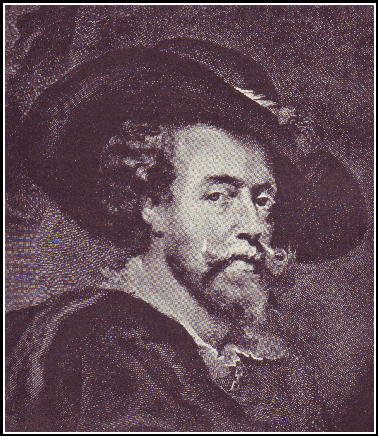 PETER PAUL RUBENS. |
Peter Paul Rubens
1577—1640.
In our study of Raphael, we had a glimpse of the golden age of art in Italy. In our work on Murillo, we saw what Spain was able to produce in pictures when the whole of Europe seemed to be trying its hand at painting. Moving north, we are to see in this sketch what the little country now known as Belgium produced in the same lines. For this we need hardly take more than the one name, Peter Paul Rubens, for he represented very completely the art of Flanders or Belgium, as we call it to-day.
If we love to read of happy, fortunate people, as I am sure we do, we shall be more than pleased in learning about Rubens. You know there is an old story, that by the side of every cradle stand a good and an evil fairy, who by their gifts make up the life of the little babe within. The good fairy gives him a wonderful blessing, perhaps it is the power to write poems or paint pictures. Then the bad fairy, ugly little sprite that he is, adds a portion of evil, perhaps it is envy that eats the soul like a canker. And so they alternate, the good and evil, until the sum of a human life is made up, and the child grows up to live out his years, marked by joy and sorrow as every life must be.
As we look at the men and women about us we feel, often, that one or the other of these fairies must have slept while distributing their gifts and so lost a turn or two in casting in the good or ill upon the babe, so happy are some lives, so sorrowful are others. At Rubensí cradle the evil fairy must well nigh have forgotten his task, for the babe grew up one of the most fortunate of men.
In order to understand as we should any great man, we must always study his country and his time. No man can be great enough not to be like the nation that produced him, or the time when he came into the world. For these reasons we love to study a manís time and country, and, indeed, find it quite necessary if we would understand him aright.
It is impossible to think of Rubens without associating him with Flanders and with Antwerp, his home city. Here, then, is just a little about the history of this most interesting country: One of the richest possessions of Spain in the sixteenth century was known as the Netherlands. When the doctrines of Luther began to spread many of the Netherlanders accepted them. Philip II., the terrible and gloomy king of Spain, seized this opportunity to persecute them cruelly. Many of them resisted, and then Philip sent his unscrupulous agent, the Duke of Alva, to make the people submit. This he partially accomplished by the greatest cruelty. The northern provinces, which we know as Holland, declared their independence. The southern, of which Flanders was the most flourishing province, longed so for peace and the prosperity that accompanies it, that they submitted to Spain. The people then grew rich as weavers, merchants and traders. Splendid cities like Bruges, Ghent and Antwerp became the seats of commerce and their artists and workmen of all sorts were known throughout Europe for their thrift and the excellence of their workmanship. We recall how Raphaelís cartoons were sent to Flanders to be copied in tapestry the finest in the world.
Of all the cities dear to Flemish hearts Antwerp was, perhaps, the most beautiful and the most prosperous. It was situated on the river Scheldt about twenty miles from the sea. In the time of its greatness one might count almost at any time twenty-five hundred ships and boats riding at anchor in front of the city, and within her walls, two hundred thousand people lived in plenty. There were marble palaces, beautiful churches, a magnificent town hall (Hotel de Ville); and the houses of the humble showed by their cleanlines and comfortable surroundings that enjoyment of life was restricted to no one class.
This matter of religious faith, however, was bound to come up again and bring, as it proved, ruin upon the city. A body of people who thought it wrong to have pictures and statues of saints, and of Mary and her Son, gathered together and for four days went from one Flemish town to another and destroyed everything of the sort to be found in the churches. Four hundred places of worship were desecrated, many of them within the city of Antwerp. Because of their zeal against the use of so-called images they were called Iconoclasts.
If formerly they had been punished for thinking things against the established religion of the State, what now could be expected when they had done such sacrilegious things?
|
"Again the whiskered Spaniard all the land with terror smote; And again the wild alarum sounded from the tocsinís throat." |
Our imagination cannot picture things so terrible as were perpetrated upon the inhabitants of Antwerp for their part in the destruction of the "images." This terrible event is known in history as The Spanish Fury. Thousands of her people were killed, most of her palaces were burned, and the treasure of her wealthy citizens was stolen. Property was confiscated to the Spanish Government. Death and terror, theft and rapine reigned in the beautiful city of the Scheldt. When the dead were buried, the charred ruins of buildings removed, and the Spanish soldiery withdrawn, the mist-beclouded Netherland sun shone out on a dead city which even to-day bears marks of the Spaniardís fury. Grass grew in what had been its busiest streets, trade almost ceased, and thousands of weavers and other artisans went to England where they could pursue their vocations unmolested.
Philip was apparently satisfied with the chastisement he had inflicted. He began to restore the confiscated property to its rightful owners, and to encourage the industry he had so cruelly destroyed. He even made Flanders an independent province under the Archduke Albert and the Infanta Isabella. Although peace had returned and a degree of prosperity again prevailed, yet many other things were irretrievably gone, and the people lived every day in the sight of painful reminders of their former greatness.
In art, too, these low country provinces had made much progress. There had been Hubert and Jan Van Eyck who had painted with minute skill devout pictures. They had, moreover, given to the world the process of painting in oils. This discovery, worked out with the extreme care natural to the Netherlanders, changed the whole character of painting, and made it possible to have such colorists as Titian, Raphael and Rubens. We must remember that the colors used in fresco painting were mixed with a sort of "size" and that they had none of the richness of oil colors. There had been other artists of note besides the Van Eycks. Hans Memling, with the spirit of a real poet, had painted his sweet visions, and to-day it is not for the opulent merchants who added fame and wealth to their city in their time, but for this poet-painter, Memling, that we venerate the ancient and stately city of Bruges. Quentin Matsys, the brawny blacksmith, who, for love of an artistís daughter, became a painter, comes to our minds as a name of no mean fame in the early records of Flemish painting.
The guild system, where every class of artisans was organized for protection and for the production of good work, touched even the fine arts. No man could set up for a good painter who had not served his apprenticeship, and whose work was not satisfactory to experts. When Rubens was born he came as the heir of all that had been accomplished before him. He only carried on what his predecessors had begun, but he carried it on in a matchless way so that he was able to leave to succeeding painters not only all he had inherited, but a goodly legacy besides—the legacy of a pure life, a glowing, natural, vigorous art. It seems to me that right here is a lesson for us. May we not add our mite, tiny though it be, to the ever-growing volume of truth? I like this quotation in this connection, and I hope you may see its beauty too—"The vases of truth are passed on from hand to hand, and the golden dust must be gathered into them, grain by grain, from the infinite shore."
Rubensí birth took place in 1577, the year following the Spanish Fury. When he was only seven, William the Silent, the saviour and protector of the northern provinces, was assassinated at the instance of Philip II. When he was eleven, the Spanish Armada, the proudest fleet that ever sailed the seas, sent to invade England and punish Queen Elizabeth, was scattered by wind and wave and dashed to pieces on alien rocks. The Reformation was well established in England and Holland, while France, led by Henry IV., was yet uncertain whether or not to accept the new doctrines. Such were some of the portentous events that marked the advent and early years of the greatest of Flemish painters.
The family of Rubensí father had lived for years in Antwerp, but when Lutherís doctrines were put forward Jan Rubens, the father of our artist, believed in them. For this reason he was compelled to flee from the city, and his property was confiscated. He went to the little village of Siegen, in western Germany, where his illustrious son was born on June 29th, 1577. His birth was on the day dedicated to the saints, Peter and Paul, and so his parents gave the child their names. After the residence of a year in this little town, the family removed to Cologne, where they lived for ten years, until the death of the father.
Jan Rubens was a lawyer and a learned man, and he took pains that his sons should be thoroughly educated. In addition to his heretical views regarding religion he had grievously offended William the Silent and so was doubly exiled. His wife remained with him, and by her efforts kept him from prison, and added cheer to his life of exile. This was the admirable Marie Pypeling, the mother so revered by Rubens, and so deserving the respect of all who know of her. A portrait of her by her son is given in this sketch. To her he owed his handsome face, his strong physique, his shrewdness and his love of order.
Immediately after the death of her husband, Marie Pypeling and her family, now consisting of two sons and a daughter, returned to Antwerp. Her property, which had been confiscated in those wild days at Antwerp, was restored to her in the general restitution with which Philip tried to compensate the citizens for their losses in the Spanish Fury. From this time Rubens was an adherent of the Catholic Church.
The education of Peter Paul, which was so carefully begun by his father, was continued by his mother, in a Jesuit College at Antwerp. He was an apt student and soon attained the elements from which he became a very learned man. He knew seven languages, was interested and learned in science and politics. All through his life he devoted some part of each day, however busy he was with his painting, to general reading. This, perhaps more than his early studies, accounts for his elegant scholarship.
His mother was quite determined that this son should be, like his father, a lawyer. His own tastes, however, and a power to use the brush early displayed, decided otherwise. It very soon became evident that he was to be a painter—good or bad—who could tell in those early days?
In accordance with a custom of the time, he was placed as a page in the house of a nobleman of Antwerp. To the talented and restless boy this life was intolerable, and he soon induced his mother to allow him to enter the studio of Van der Haeght, a resident artist of some repute and a close follower of Italian Art. He was only thirteen at this time. Here he learned to draw skillfully and, through the influence of his teacher, he acquired a love of landscape art which never left him.
From Van der Haeght and his mild but correct art, Rubens, feeling his weakness in figure work, went to the studio of the irascible and forcible painter Van Noort, about whom critics have delighted to tell stories of brutality. However true these may be, Rubens stayed with him four years and never ceased to speak in praise of his masterís work. Here he became acquainted with Jordaens, who used often to paint the animals in Rubensí landscapes.
From Van Noortís studio the restless Rubens went to study with Van Veen, who afterwards became court-painter. When the Archduke Albert and Isabella entered Antwerp in 1594, it was Van Veen who decorated the triumphal arches used on the occasion. We may judge that he did the work well, for he was shortly selected to serve the new rulers as court painter. Rubensí experience with Van Veen closed a ten yearsí apprenticeship in the studios of Antwerp, and now he determined to go to Italy, where he could study the masters at first hand.
As a sort of parting work and, perhaps, because he wished to impress more vividly on his mind those dear, strong features of his mother, he painted that portrait of her which we so much admire both for its subject and its art. This image of his mother was an effectual charm to carry with him in his travels—a charm to save him perhaps, from some of the stumbling places into which a handsome young man away from home might wander.
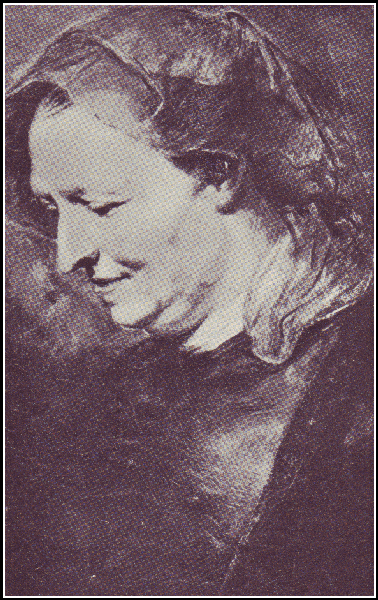 RUBENS' MOTHER. |
In May of 1600, after making all needful preparation, our artist set out on his journey. It was natural that he should direct his steps first to Venice. Titian had but recently completed his productive life of nearly a century. His misty atmosphere, his intense interest in human life and, above all, his glowing color touched a kindred cord in Rubensí nature. Then there were Tintoretto and Veronese, almost as interesting to our painter.
The Duke of Mantua, a most liberal and discerning patron of art, was in Venice when Rubens reached that city. One of the Dukeís suite happened to be in the house with Rubens. He took notice of the painterís courtly bearing, his fine physique, and his ability to paint, and introduced him to the Duke. Never did our painterís handsome face and fine presence so quickly win a patron. He was at once attached to the Dukeís court and began copying for him the masterpieces of Italy—the pictures of Titian, Correggio, Veronese, leading all others. He also studied carefully the work of Julio Romano, Raphaelís famous pupil. He accompanied the Duke to Milan, where he copied Leonardoís great picture, "The Last Supper," besides doing some original work.
The Duke had observed Rubensí courtly manner and his keen mind. He decided that the painter was just the person to send in charge of some presents to the King of Spain, whose favor he was anxious to gain. The gifts were made up of fine horses, beautiful pictures, rare jewels and vases. Early in 1603, the painter set out with his cavalcade, and after a stormy journey of about three months they reached the Court of Spain. He was cordially received and the gifts were delivered, although the pictures had been somewhat damaged by the rains which marked the last days of their trip. He was asked to paint several portraits of eminent personages of the court and he complied graciously.
He returned to Italy after somewhat more than a yearís absence. For some time he remained at Mantua to paint an altar-piece for the chapel where the Dukeís mother was buried.
Later he went to Rome where he studied carefully the works of Michael Angelo. In turn he visited all the great art cities of Italy except Naples. He stopped for some time at Florence, Bologna, and Genoa. At the last place he received so many orders for his work that he could not attend to them all. Everywhere he went the fame of "the Fleming," as he was called in Italy, had gone before him. In many of the cities he made lengthy sojourns, copying the masterpieces that pleased him, and painting originals highly prized to-day in the galleries of Italy.
He had been in Italy eight years, when one day from over the Alps came a courier in hot haste bearing to Rubens the sad news that his mother lay at home very ill. Not even waiting for permission from his patron, the Duke, Rubens started north with a heavy heart, for he felt sure that he should never see his mother again. Although he rode with all haste, as he neared his home city of Antwerp, he received the sad tidings he had so much dreaded. Marie Pypeling had died nine days before he left Italy. As was the custom in his country, he secluded himself for four months in a convent attached to the church where his mother was buried.
The profound sorrow for his mother, and the sudden change from the life he had so recently led made him melancholy. He longed for the skies, the pictures, and the society of Italy. When he came forth from his retirement, his countrymen could not bear the thought of their now illustrous artist returning to Italy. They wanted him among them to glorify with his splendid brush the now reviving city of the Scheldt.
The rulers of the city, Albert and Isabella, made him court painter and gave him a good salary. He accepted the office on condition that he should not have to live at the court. It was with some regret that he gave up returning to Italy, but the natural ties that bound him to Antwerp were stronger. He hoped that he might yet one day visit Italy. This part of his life-plan, however, he never carried out.
He was now thirty-two years old, respected of all men not only for his power as a painter, but for his sterling worth as a man. He had studied carefully the best art that the world could show, and he had absorbed into his own characteristic style what was best for him—his style of painting was now definitely formed. His fame as a painter was established from the Mediterranean to the Zuyder Zee. He was overwhelmed with orders for his pictures, so that he had plenty of money at his command. He had the confidence of princes, and was attached to one of the richest courts of Europe. A crowd of anxious art students awaited the choice privilege of entering his studio when he should open one. It would seem that there was little left for this man to desire in earthly things. The two he lacked he speedily procured, a good wife and a happy home, both destined to live always on the canvasses of this most fortunate of painters.
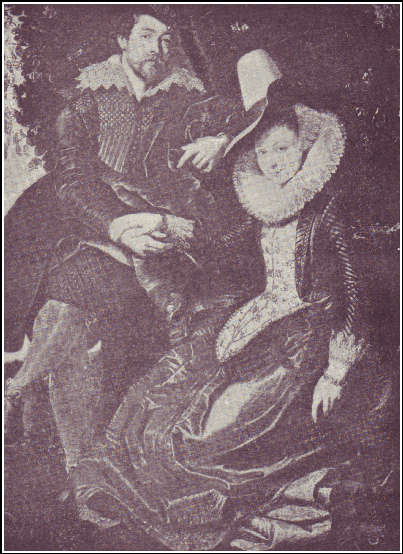 RUBENS AND HIS FIRST WIFE. |
In 1610, he married the lovely and beautiful Isabella Brandt, the daughter of the Secretary of Antwerp. Happy indeed were the fifteen years of their life together, and often do we find the wife and their two boys painted by the gifted husband and father. We reproduce a picture of the two boys.
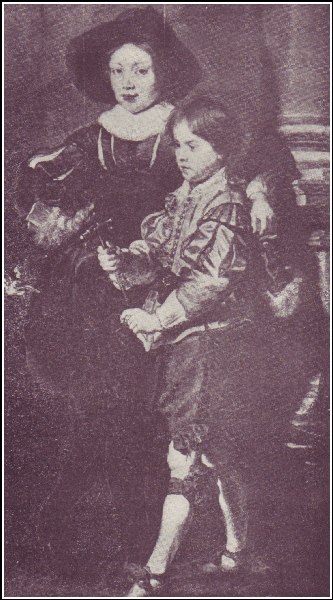 RUBENS' TWO SONS. |
He bought a house on Meir Square, one of the noted locations in Antwerp. He re-modelled it at great expense in the style of the Italians. In changing the house he took care that there should be a choice place to keep and display his already fine collection of pictures, statues, cameos, agates and jewels. For this purpose he made a circular room, lighted from above, covered by a dome somewhat similar to that of the Pantheon at Rome. This room connected the two main parts of the house and was, with its precious contents, a constant joy to Rubens and his friends. The master of this palace, for such it certainly was, lived a frugal and abstemious life, a most remarkable thing in an age of great extravagance in eating and drinking. Here is the record of one of his days in summer: At four oíclock he arose, and for a short time gave himself up to religious exercises. After a simple breakfast he began painting. While he painted he had some one read to him from some classical writer, and if his work was not too laborious, he received visitors and talked to them while he painted. He stopped work an hour before dinner and devoted himself to conversation or to examining some newly acquired treasure in his collection. At dinner he ate sparingly of the simplest things and drank little wine. In the afternoon he again began his work at his easel, which he continued until evening. After an hour or so on a spirited Andalusian horse, of which he was always passionately fond, and of which he always had one or more fine specimens in his stables, he spent the remainder of the evening conversing with friends. A varied assembly of visitors loitered in this hospitable home. There were scholars, politicians, old friends—perhaps former fellow-pupils in Antwerp studios. Occasionally the princess Isabella came among the others, and Albert himself felt honored to stand as god-father to Rubensí son. Surely the wicked fairy did forget some of the evil he was to have mixed with this life!
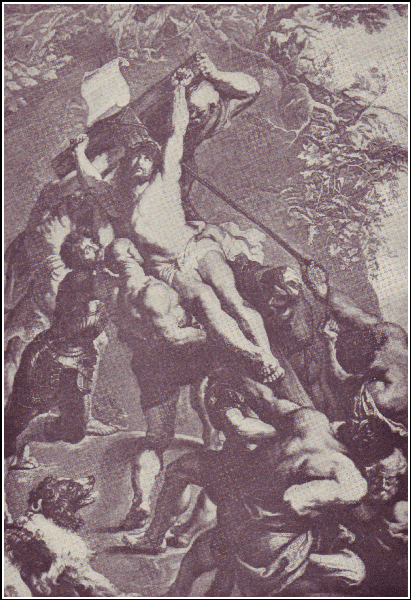 ELEVATION OF THE CROSS. |
It was in connection with the building of this house that the best known and perhaps the greatest work of Rubens was painted: "The Descent from the Cross," now in Antwerp Cathedral. It is said that in excavating for the foundation to some of the new parts of Rubensí house, the workmen unintentionally trespassed on some adjoining ground belonging to the gunsmithsí guild. In settlement for this Rubens was requested to paint a picture of St. Christopher, the Christ-Bearer, as they called him. Rubens complied with the request and painted what to us to-day would seem a very strange picture—a "triptych," that is a middle panel over which two narrow side panels, hinged to the middle one, could be closed. He interpreted the request of the guild rather strangely too—he thought it would please them to represent in the several spaces of the triptych all who had ever carried Christ in their arms. In the middle panel we have the men removing the dead Christ from the cross, with the three Marys below, one of whom, the Magdalen, is, perhaps, the most beautiful woman Rubens ever painted. The light is wonderful, coming, as it does, from the great white cloth in which they would wrap our Lord. The form of the dead Christ in its difficult position is a piece of masterly drawing. This panel is, of course, the principal part of the altar-piece. On one side of this was painted the Virgin visiting St. Anne, and on the other we have the aged St. Simeon presenting the Christ-Child in the temple. If we close these side panels over the middle one we find a space as large as the center panel. On this Rubens painted St. Christopher with the child and accompanied by a hermit carrying his lantern. Surely it was a good-natured artist and a glowing and generous soul who painted so much in response to a request for a St. Christopher!
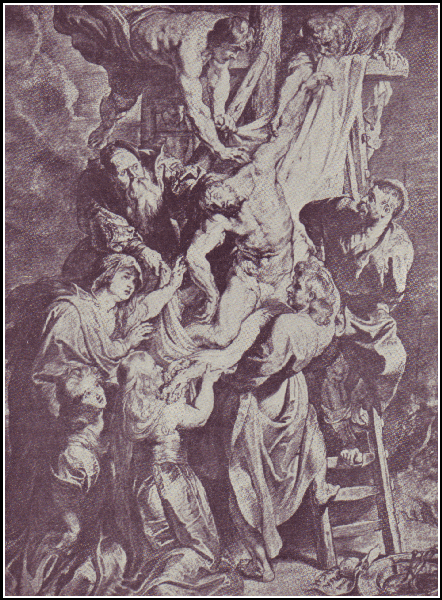 DESCENT FROM THE CROSS. |
There were, however, trials for this fortunate man. There were those who were jealous of his fame and who said unkind things of him. In answer to their jealousies he only said, "Do well and you will make others envious; do better and you will master them."
 HOLY FAMILY. |
He was called away from the home he loved so well. In 1619, when the truce, under which Antwerp had regained somewhat of her former greatness, was about to expire, Rubens was sent to Spain to renew it. He had hardly returned to Antwerp before Marie de Medicis, the wife of Henry IV. of France—the Henry of Navarre, of historic fame—sent for the artist to adorn her palace of the Luxemburg in Paris. He was to paint twenty-one pictures for this purpose. They were to describe the life of the queen. We give one of the series. He accomplished this entire work in glowing allegorical fashion in which mythological and historical personages are sadly confused at times. If there was occasionally this confusion, there were also present the artistís strongest characteristics as a painter—rich color and vigorous human action.
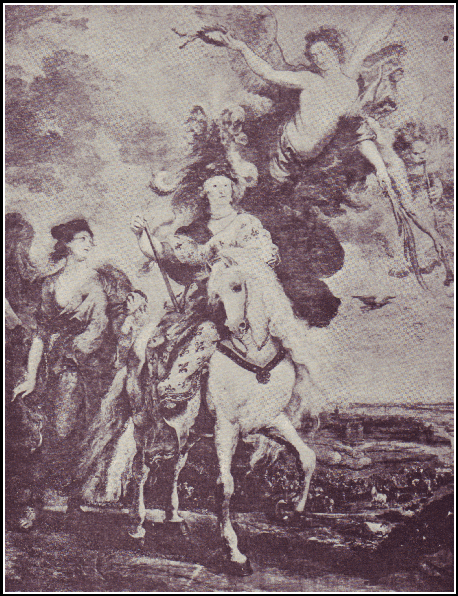 MARIE DE MEDICIS. |
While in Paris he became intimately acquainted with the Duke of Buckingham, the favorite of Charles I. of England. This nobleman visited Rubens at his home in Antwerp and he was so pleased with the artistís collection that he offered him ten thousand pounds sterling for it complete. Rubens hesitated, for in the collection there were nineteen pictures by Titian, thirteen by Veronese, three by Leonardo, and three by Raphael, besides many of his own best works. The artist, however, was always thrifty, and he felt sure he could soon gather another collection, so he accepted the offer.
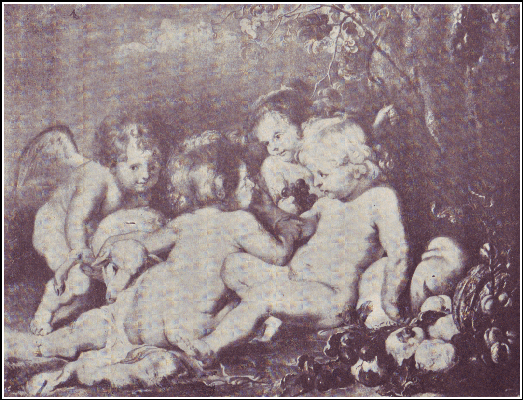 INFANT CHRIST, ST. JOHN AND ANGELS. |
In 1626, his lovely wife died. He mourned her deeply, saying "she had none of the faults of her sex." To beguile his time he accepted another diplomatic mission to Spain. This time he was to secure a strong ally for Spain against the powerful Richelieu who then held France in his hand as it were. Incidentally he painted much while at Madrid. Among other work he copied the Titians which were likely to be taken out of the country at the marriage of the Infanta. At this time, too, he undoubtedly met Velazquez, the able and high-souled court painter of Philip IV. This was certainly one of the most notable meetings in the history of artists.
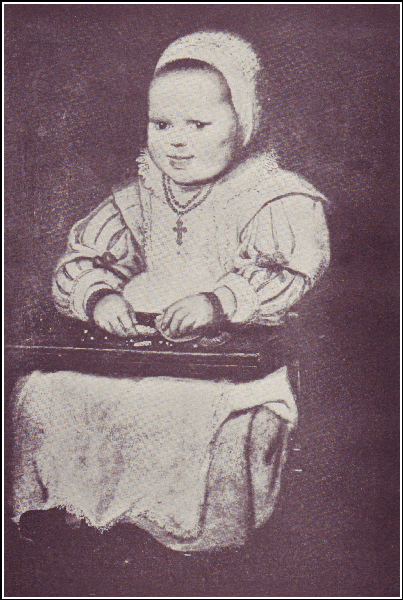 RUBENS' DAUGHTER. |
It was while at the court of Madrid at this time that Jean of Braganza, afterward King of Portugal, invited the artist to visit him at his hunting-lodge, and Rubens set out with several of his followers, as was usual with travellers of note in those days. Before he reached the lodge Jean, hearing of so many attendants, and dismayed at the expense of entertaining them, departed suddenly for Lisbon. He wrote Rubens a courteous letter telling him that state business detained him and begged him to accept some money to defray the expenses so far incurred on the journey. Rubens replied in like courteous manner and returned the money, saying that they had brought twenty times the amount with which to pay their expenses.
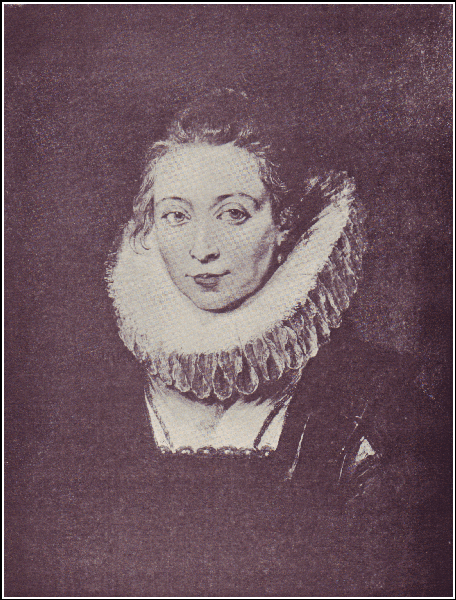 PORTRAIT OF A YOUNG WOMAN. |
An interesting story is related of their return. Overtaken by dark night in the open country they took shelter in a monastery. The next morning Rubens, with an eye always quick to see rare and interesting things, scanned the place carefully looking for something which might interest him. He was about to give up the search as hopeless, when he discovered in a dark corner a grand picture. It represented in more than mortal fashion the beautiful things that a dead young man, painted in the foreground, had renounced. Rubens called the prior to him and begged to know the name of the artist of so masterly a work. The prior, an old, bowed man, refused saying, "He died to the world long ago. I cannot disclose his name." Then the artist said, "It is Peter Paul Rubens who begs to know." The prior started, for even in the remoteness of the isolated monastery the fame of that name had gone, and fell in a dead faint at the artistís feet. The attendants lifted the prior gently but he had ceased to live. Through the ashy pallor they saw the features of the young man in the picture yonder. They instinctively turned to look that they might more carefully compare the faces, and lo! like some cloud-vision, the picture had disappeared. Then they knew that the dead monk there had painted the canvas from the depth of his own experience.
From Madrid, Rubens was sent to England in the interest of Spain. Here he was most kindly received by Charles I., who made him a knight and presented him with his own jeweled sword and a diamond ring. He also gave him a hat-band set with precious stones which was valued at two thousand pounds sterling. From London he went to Cambridge where the ancient university conferred on him its highest degree. In London he painted almost constantly. Among other commissions he was given that of decorating the dining room in Whitehall palace with nine pictures representing the life of James I. To make the person or events of this kingís life attractive must have been an immense task even for so supreme a genius as Rubens.
As he sat painting one day a courtier entered and exclaimed, "Ah, his Majestyís Ambassador occasionally amuses himself with painting." "On the contrary," responded Rubens who was always proud of his art, "the painter occasionally amuses himself by trying to be a courtier."
The influence of Rubensí visit to London must be counted rather as artistic than political. It really was the beginning of that desire for collecting pictures and other things of the sort which has ever since distinguished the English nobility. On the Continent the price of pictures rose on account of Englandís demand. For Charles I., Rubens bought the entire collection of the Duke of Mantua which he knew so well.
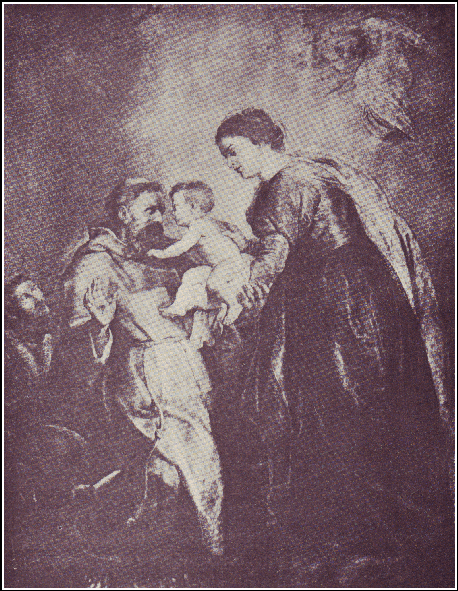 MADONNA AMD CHILD WITH ST. FRANCIS. |
Rubens was tired of the almost fruitless mission at various courts and was glad to give up the business of an ambassador and return to Antwerp and to the life of a private gentleman. We must not forget that all these years Rubens was painting a great number of pictures in his ripest style. There was hardly a class of subjects or size of canvas which he could not skillfully use, although he always maintained that he could do his best work on large surfaces. There were religious pictures of Madonnas and saints all crowded with numerous figures and filled with vigorous human action. There were portraits such as those of his wives, of Elizabeth of France, or "The Girl with a Straw Hat," which rank among the best of the world. There were wonderful animal pictures—hunting scenes, the excitement of which even to-day makes the cheek glow. There were historical scenes mingled with allegory. There were most beautiful children whose fat and agile bodies and whose laughing faces make us want to hug them. There were enchanting angels, and there were huge fauns and satyrs. There were placid landscapes where, it may be, the artistís soul, teeming with the life of all time, took its rest and recreation sporting with the nymphs of the woodland streams or with the frisky dryads of the trees.
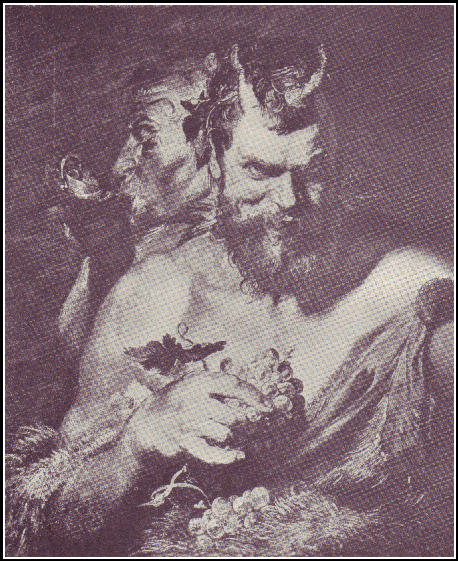 SATYRS. |
In 1630, at the age of fifty-three, he married his second wife, Helen Fourmont, only sixteen years old. Like his first wife she was very beautiful, as his numerous portraits indicate. Five children came to them and the felicity of his early years with Isabella Brandt continued with his second wife.
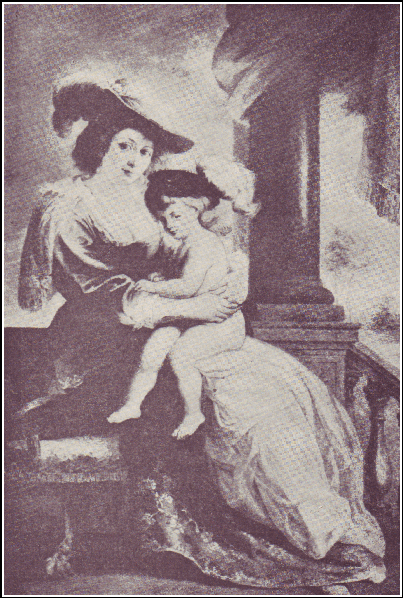 HELEN FOURMONT, RUBENS' SECOND WIFE, AND YOUNGEST SON. |
The health of our painter gradually gave way. For many years he had suffered intensely from repeated attacks of gout. As he aged, these became more and more frequent and severe. Often the disease, working in his fingers, kept him from painting. "The Death of St. Peter" was painted for Cologne Cathedral in 1635. It seems as if in his last years his heart turned affectionately to the city of his boyhood home and he would thus commemorate it. Another picture belongs to these last years. It was a family picture which he called "St. George." It represented four generations of the painterís family and included both his first and his second wife. He himself figured as the Saint, clad in shining armor and triumphant over his late enemy, the deadly dragon. Rubens was too great to be conceited, but he stood at the end of a most successful life. If ever a man had conquered the dragon of disappointment, that lies crouching at the door of every life, Rubens had. He did well to represent himself as St. George. In both of these last pictures the painter shows at his very strongest.
He died May 30th, 1640, and was buried in the church beside his mother and his first wife. All the city attended his funeral, for in three capacities they mourned their illustrious citizen—as an artist, as a diplomat and scholar, and as a man of noble character. Two years after his death the picture "St. George" was hung above his tomb where it is found to-day.
He left great wealth which was largely represented by his collection of pictures and jewels. There were three hundred and nineteen paintings, all masterpieces. The collection sold for what would be in our money about half a million dollars. This is a large sum at any time but in Rubensí day it was well nigh fabulous.
Rubens has left us more than fifteen hundred pictures bearing his name. That any man could leave so many can be accounted for only by reckoning many of them as largely executed by his pupils. He used to make small sketches in color and hand them over to his pupils for enlargement. He was always at hand to make corrections and, at the end, to give the finishing touches. He used to charge for his pictures according to the time he used in painting them, and he valued his time at fifty dollars a day.
He shows none of the mystical visionary feeling of the Spaniards even in his religious pictures. He was too much in love with life for that, and so, sometimes, we are offended by stout Flemish Saints and Madonnas too healthy to accord with our notions of their abstemious lives. In his pictures there is spirited action, almost excess of life, and rich unfading color in which the reds largely prevail. His lights are fine but the deep, expressive shadows that made Rembrandt famous are entirely lacking. The softly flowing way in which the color leaves his brush is, perhaps, the most inimitable part of his art. On this account someone has said, who evidently has great reverence for both Velazquez and Rubens, that we will see another Velazquez before another Rubens.
Considering the qualities of his art, the number of his pictures, his scholarship, his eminence as a diplomat and his pure and honorable life, we must place Rubens among the very greatest men who ever wielded a brush.